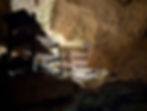Northern Spain's Prehistoric Caves, Mine Tours and Subterranean Highlights
- Maria DiCicco
- Apr 29
- 6 min read
Updated: Nov 24
What a mouthful of topics, but in subterranean Northern Spain, you'll find the most fascinating creations made both by man and by nature.
Below, discover attractions for visitors to experience first hand the history of not only a nation or a gastronomy of a region, but also uncover some of the secrets of early man.
I've only visited some of these in my recent travels on a Northern Spain road trip, but the research was too good not to share. Let's dive in.
Note: Always Pack Tissues represents many tried and tested travel sites as what is called an 'affiliate' partner. That means if you click on my ads I may get a commission from a resulting sale. As an Amazon Associate I earn from qualifying purchases. For information on how this may impact your privacy rights, please consult my privacy policy.

Prehistoric Caves in Cantabria and Northern Spain
Going underground we can find the stories of stone, of stalagmites and stalagmites and drippy seawater growth aging and strengthening millimeters of an inch year over year (actually, Google tells me it is 0.13 millimeters per year (0.005 inches))!
But on top of the generally very fascinating underground world of cuevas (caves) in Northern Spain, the region of Cantabria in particular has an even greater story to tell.
Known predominantly for their prehistoric cave paintings, many of the Cantabrian caves are enclosing the secrets of ancient man from 20,000 years ago.
Here's a few places where you can get underground in Northern Spain and explore more for yourself:
Cave of Altamira
The number one reason to visit the cute medieval village of Santillana del Mar isn't necessarily the cobbled streets or charming castle-like stays, but rather - the Cave of Altamira!

This stunning and impressive replica cave is well worth a visit, even though it is a replica. In fact, when I read that it was a replica of the real cave, which has long been sealed due to over tourism, I felt it wouldn't be worth seeing. Boy was I wrong.
Inside, start your tour with a timed ticket entry to see a preview video of what the caves were like 20,000 years ago.

Be introduced to ancient man, how they lived and ate, and what happened to them (spoiler alert: the entry caved in and they all perished).
In the late 20th century, however, the cave was discovered and with it, magnificent and intact cave paintings were also discovered.

After the video, step into the entrance of that cave, as if it were real, walking deep underground into a dimly lit space where you'll see a staged recreation of the archaeological dig and artifacts found in the actual Cave of Altamira.

A little lower in the cave, find the cave paintings.

Truly tremendous, the exhibit doesn't end underground. The museum adjacent to the replica cave holds more artifacts and stories of man from so many thousands of years ago.
Plan for 1.5 hours to soak it all in.
Visits are free for all children under the age of 18 and for seniors. Adults are only 3 euros.
Visit with a tour: Click here for information.
Cueva El Soplao
Another popular cave system in the same area, this one is unique due to its mine train entry. Certainly fun for families with children, this should be booked in advance to avoid disappointment!
Tours are available from 10-2 and 3-6. They take approximately 1 hour.
Visit with a tour: Click here for information.
Cueva El Castillo
Tack this onto your list if you want to visit a prehistoric cave in person (and not just a replica). Part of a group of pre-historic caves with cave paintings, Cueva El Castillo has specific instructions from visitors on their complicated ticketing system.
Reserve your tickets online in advance and then pick them up at the Rock Art Centre of Cantabria about 45 minutes before your tour. After you've retrieved your tickets, drive about 5 minutes to the parking lot and walk to the cave entrance for your tour time.
Cueva El Pendo
Another one worth noting!
Cheese Caves in Northern Spain
When I learned about the cheese caves in Northern Spain, I couldn't help myself. I HAD to see one. The thing is, seeing an actual cheese cave is a lot like seeing the pre-historic cave art at the Cave of Altamira - no es posible! (It's not possible!).
Because the cheese is sensitive to the temperatures, varying comings and goings of humans and so forth, it's generally ill-advised to expose cheese aging in caves to outside sources. I.e., us tourists.
But luckily, I researched (deeply) and found three such caves offering tours for cheesemongers like myself.

Queseria Main
Highlighted in my article about the best cheese and cider in Asturias, Queseria Main is an off the beaten path cheese maker in Sotres.
Promoted with many world cheese awards, this shop offers amazing tours around their farm, cheese making room, and of course - the cheese cave.
The mini-adventure to the cave also includes a lovely tasting at their farm shop at the end.
Learn more here: https://quesosdecabrales.es/home/
Cueva del Queso de Cabrales
Another highlighted on my cheese article, I visited this quirky exhibit in April, just before the summer tourists started flocking in.
Part-museum, part-cheese cave, the tour starts within cave walls. You'll see several exhibitions on how cheese makers lived and worked, and many of the tools they used.
The tour was in Spanish, but English information was provided on tablets as a supplement.

The time in the cheese cave was brief, but very interesting nonetheless. We were told that the cheese in the cave was real, but for display purposes only.

After the tour we enjoyed an explanatory video alongside a cider and cheese tasting. In total we spent about 1 hour, plus a few minutes to browse the souvenirs and take home some cheese for ourselves.
All in all, it was very enjoyable and ticked the box I needed to tick for seeing a cheese cave in person!
Queliama Cheese Cave
Now if I HAD been in Asturias for summertime, THIS would be the tour to book: https://www.onisecoturismo.es/en/guided-tour-quiliama-cave-benia-de-onis/
For a meager 3 euro fee, visitors put on protective clothing and cross streams to get to the drippy cheese cave featuring ("recreations") of gamoneu cheese. Sorry, you just can't seem to get up close to the real stuff!
The walk to the cave is 1.3km, so be prepared for that! (I think it's part of the fun).
The tour of course ends in a cheese tasting, and lasts about 1 hour.
Note also that tours are only offered in July and August and are conducted from the Benia de Onis visitor's center. Be sure to arrange online in advance.
Kid's are welcome!
Mine Tours in Asturias
Industrial heritage stems back for decades in Asturias. Coal is one of the largest mining draws in Asturias, as well as metals like iron.
Most mines are closed, but many are still very much in operation, as you'll notice on your drive through Northern Spain.
Some are now set up for tourism, like the exhibits below:
This family-friendly mine tour was an absolute hit with my five year old, and an informative blast for the adults. Starting with a harrowing and honestly, nerve-wracking mining train ride into the gut of the mountain, you'll clickety clack about 2km into the earth in a little yellow box.

As trees and foliage of the outdoors disappears, we were swallowed in darkness, with the clever tour operators piping in authentic mining noises as we roared through the stone tunnel.
After the exciting ride, we ended at a depot of sorts, still underground, where we learned about the elevator system that took both coal and the miners (separately) up and down to the manufacturing area of the mine.
Ascending up the same elevator shaft, we found ourselves in a large complex dating back to the 1920s and 1930s, with some very cool machinery along with it.

We learned about the engine that powered the cages, which held 45 men in them, and tons of coal.

A technical tour conducted entirely in Spanish, they do offer a translator as needed for this part of the tour.

You'll visit the various rooms of the mining complex like the company offices and the lamp house, but the most interesting was seeing the way the miners lived and worked.
We visited the bathhouse, where filthy coal-stained clothing would be hung on hooks, and the medical areas where the miners would be treated for injuries.

Each building was loaded with history and really fascinating facts.
The tour lasts 2 hours (approximately) and is worth every single penny (and then some). Adults are 11 euros and children are free (to age 3) and 4 euros (ages 4-11). I recommend buying your tickets online in advance.
Please note that if you are claustrophobic or afraid of tight underground spaces, there IS an option to skip the train and walk to the mining complex to join the tour. The walk is about 2km, if I recall. I think the logistics of that will be more challenging, however, and the experience would not be as enjoyable.
Other great options for experiencing Asturias' mining past:
Visit Pozo Soton mine for an inside look.
This museum includes a visit to the mine underground.
This mine tour goes underground to a couple of tunnels.
For more on Northern Spain, discover the town where anchovies are king, the Basque fisherman's village known for creating kalimotxos, and more, all right here on the blog!






























